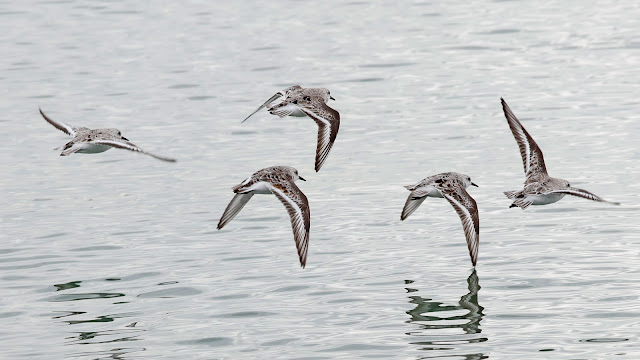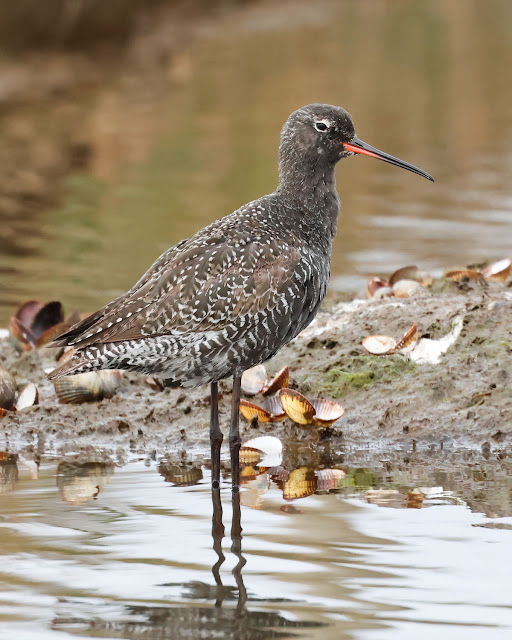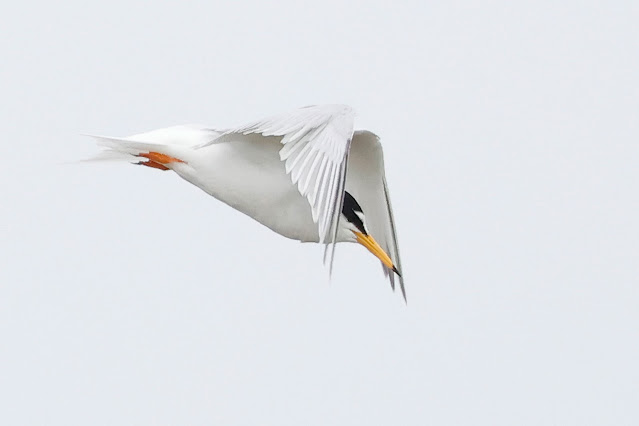I hadn't been down to Titchfield for awhile and decided to start there today. After checking in I walked around to the sea wall opposite the reserve west entrance. It was an overcast, cold day with a north westerly wind, the sea though was very calm and the tide rising. A Bar-tailed Godwit was on the beach, but then flew off and headed towards the reserve and out of sight.
There was a significant movement of hirundines, mostly Swallows, but also Sand and House Martins, coming in off the sea and heading across the reserve and up the valley. This was the first large number of hirundines I have seen this year.
On the beach were Turnstones and about twenty Sanderling, many of which were showing partial summer plumage.
A flock of eight Little Terns came in off the sea and they too flew across the reserve. This raised the hopes of something happening on the water, would this be the first real movement of the spring.
It didn't really happen, but there were three Whimbrel that passed, while one was seen very high up circling above us.
The notable sighting of the morning was of two Dolphins that wee picked up in the mid channel of the Solent. They were either Common or Bottlenose Dolphins, there were glimpses of two colours on the side when they did come well out of the water, this would indicate Common, but then the dorsal fin could be Bottlenose. I would say they were Bottlenose.
One of the many swallows to pass through.
At 13:00 the sea watch was called off, very little had moved. I decided to head on to the reserve. Mediterranean Gulls called as they passed overhead.
A quick check in the Meon Shore Hide did not produce much, so I walked down to the Spurgin Hide, where a male Marsh Harrier passed by on several occasions.
But aside from a Coot feeding her family of four chicks, there was little else going on, so I decided to head out, but stopped at the Pumfrett Hide in the hope there could be something about.
There was no sign of the Little Terns and Bar-tailed Godwits that had flown in the direction of the reserve earlier. There were plenty of Avocets paired up and this one sitting on the cause way.
When all else fails there is always the Sanderlings, and seeing them this morning on the beach in various stages of summer plumage I was interested to see if they were on the roost behind the sailing club.
Walking along the sea wall, I could see a small group so I walked carefully along the beach and edged closer. I wanted to see if I could get some different shots this time, so please bear with me as I think I have managed to get some.
They were clearly unconcerned with my presence.
Catching one behind the pebbles.
Here a chance to appreciate the reddish brown colouring coming through.
With a bit of beach litter.
Everyone likes a good scratch, it looks as if the Sanderling is smiling as it scratches.
Tucked down behind the ridge of pebbles.
Some more blurred foregrounds.
Three quarters of the summer plumage.
As I made my way back to the car, I heard a Lesser Whitethroat singing from the bramble by the viewpoint. I managed to get a glimpse as it flew across in front of me. From the bridge I could also see the Marsh Harrier pair above the river up the valley.















































































































